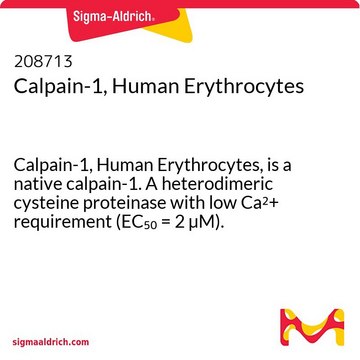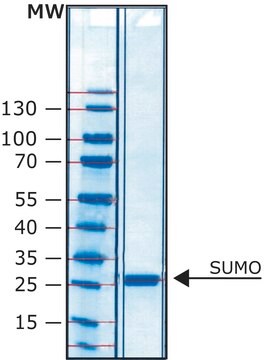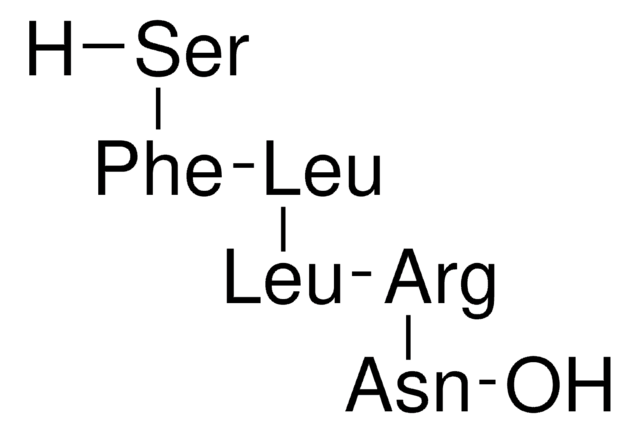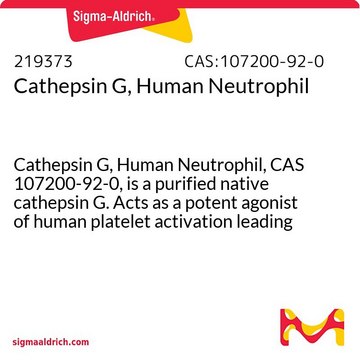208712
Calpain-1, Porcine Erythrocytes
Calpain-1, Porcine Erythrocytes, is a native calpain-1. A heterodimeric cysteine proteinase with low Ca2+ requirement (EC₅₀ = 2 µM).
Synonyme(s) :
μ-Calpain
Se connecterpour consulter vos tarifs contractuels et ceux de votre entreprise/organisme
About This Item
Produits recommandés
Niveau de qualité
Forme
liquid
Activité spécifique
≥1000 units/mg protein
Fabricant/nom de marque
Calbiochem®
Conditions de stockage
OK to freeze
avoid repeated freeze/thaw cycles
pl
5.3
Conditions d'expédition
wet ice
Température de stockage
−70°C
Catégories apparentées
Description générale
Native calpain-1 from porcine erythrocytes. Ca2+-dependent heterodimeric cysteine proteinase with low Ca2+ requirement (EC50= 2 µM). Participates in the ATP release reaction of platelets stimulated with thrombin.
Native calpain-1 from porcine erythrocytes. Calpains are a family of calcium-dependent thiol-proteases that degrade a wide variety of cytoskeletal, membrane-associated, and regulatory proteins. The two major isoforms, calpain I (µ-form) and calpain II (m-form), differ in their calcium requirement for activation. Calpain I requires only micromolar amounts of calcium (EC50 = 2 µM), while calpain II requires millimolar amounts (EC50 = 1 mM).
Calpains are heterodimers of 80 kDa and 30 kDa subunits. The 80 kDa unit has the catalytic site and is unique to each isozyme. The 30 kDa unit is a regulatory subunit and common to both calpain I and calpain II. The 80 kDa unit consists of four domains (I-IV). The 30 kDa unit has two domains (V and VI).
• Domain I is partially removed during autolysis.
• Domain II is the protease domain.
• Domain III exhibits a homology with typical calmodulin binding proteins and interacts with calcium binding domains (IV and VI) and frees domain II for protease activity.
• Domain IV is a calcium binding domain.
• Domain V contains a hydrophobic region and is essential for calpain interaction with membranes.
• Domain VI is a calcium binding domain.
More recently, attention has been focused on the pathological significance of calcium accumulation in the central nervous system following cerebral ischemia and traumatic brain injury. Over-activation of NMDA, kainate, and AMPA receptors in the brain leads to sustained influx in Ca2+ through voltage gated Ca2+ channels. Disturbances in calcium homeostasis result in the activation of several calcium-dependent enzymes including calpains. Over-expression of calpains has been positively linked to both acute and chronic neurodegenerative processes including ischemia, trauma, and Alzheimer′s disease. In Alzheimer′s disease the ratio of active (76 kDa) to inactive (80 kDa) calpain I is reported to be much higher. Calpain proteolysis is usually the late-stage common pathway towards cell death induced by excitotoxic compounds.
Calpains are heterodimers of 80 kDa and 30 kDa subunits. The 80 kDa unit has the catalytic site and is unique to each isozyme. The 30 kDa unit is a regulatory subunit and common to both calpain I and calpain II. The 80 kDa unit consists of four domains (I-IV). The 30 kDa unit has two domains (V and VI).
• Domain I is partially removed during autolysis.
• Domain II is the protease domain.
• Domain III exhibits a homology with typical calmodulin binding proteins and interacts with calcium binding domains (IV and VI) and frees domain II for protease activity.
• Domain IV is a calcium binding domain.
• Domain V contains a hydrophobic region and is essential for calpain interaction with membranes.
• Domain VI is a calcium binding domain.
More recently, attention has been focused on the pathological significance of calcium accumulation in the central nervous system following cerebral ischemia and traumatic brain injury. Over-activation of NMDA, kainate, and AMPA receptors in the brain leads to sustained influx in Ca2+ through voltage gated Ca2+ channels. Disturbances in calcium homeostasis result in the activation of several calcium-dependent enzymes including calpains. Over-expression of calpains has been positively linked to both acute and chronic neurodegenerative processes including ischemia, trauma, and Alzheimer′s disease. In Alzheimer′s disease the ratio of active (76 kDa) to inactive (80 kDa) calpain I is reported to be much higher. Calpain proteolysis is usually the late-stage common pathway towards cell death induced by excitotoxic compounds.
Conditionnement
Please refer to vial label for lot-specific concentration.
Avertissement
Toxicity: Harmful (C)
Définition de l'unité
One unit is defined as the amount of enzyme that will hydrolyze 1 pmol Suc-LLVY-AMC in 1 min at 25°C using the Calpain Activity Assay Kit, Fluorogenic (Cat. No. QIA120). Note: 1 caseinolytic unit = 9 fluorogenic units
Forme physique
In 20 mM imidazole-HCl, 5 mM β-mercaptoethanol, 1 mM EDTA, 1 mM EGTA, 30% glycerol, pH 6.8.
Reconstitution
Following initial thaw, aliquot and freeze (-70°C). Short-term storage of aliquots at 4°C or on ice is not recommended.
Autres remarques
Vanderklish, P.W., and Bahr, B.A. 2000. Int. J. Exp. Pathol.81, 323.
Sorimachi, H., et al. 1997. Biochem. J.328, 721.
Kampfl, A., et al. 1997. J. Neurotrauma14, 121.
Johnson, G.V.W., and Gutmann, R.P. 1997. BioEssays19, 1011.
Bartus, R.T., et al. 1995. Neurol. Res.17, 249.
Wang, K.K.W., and Yuen, P.-W. 1994. Trends Pharmacol. Sci. 15, 412.
Saito, K., et al. 1993. Proc. Natl. Acad. Sci. USA90, 2628.
Goll, D.E., et al. 1992. BioEssays14, 549.
Ishii, H., et al. 1992. Biochim. Biophys. Acta1175, 37.
Melloni, E., and Pontremoli, S. 1989. Trends Neurosci.12, 438.
Ross, E., and Schatz, G. 1973. Anal. Biochem.54, 304.
Sorimachi, H., et al. 1997. Biochem. J.328, 721.
Kampfl, A., et al. 1997. J. Neurotrauma14, 121.
Johnson, G.V.W., and Gutmann, R.P. 1997. BioEssays19, 1011.
Bartus, R.T., et al. 1995. Neurol. Res.17, 249.
Wang, K.K.W., and Yuen, P.-W. 1994. Trends Pharmacol. Sci. 15, 412.
Saito, K., et al. 1993. Proc. Natl. Acad. Sci. USA90, 2628.
Goll, D.E., et al. 1992. BioEssays14, 549.
Ishii, H., et al. 1992. Biochim. Biophys. Acta1175, 37.
Melloni, E., and Pontremoli, S. 1989. Trends Neurosci.12, 438.
Ross, E., and Schatz, G. 1973. Anal. Biochem.54, 304.
Informations légales
CALBIOCHEM is a registered trademark of Merck KGaA, Darmstadt, Germany
Code de la classe de stockage
10 - Combustible liquids
Classe de danger pour l'eau (WGK)
WGK 2
Certificats d'analyse (COA)
Recherchez un Certificats d'analyse (COA) en saisissant le numéro de lot du produit. Les numéros de lot figurent sur l'étiquette du produit après les mots "Lot" ou "Batch".
Déjà en possession de ce produit ?
Retrouvez la documentation relative aux produits que vous avez récemment achetés dans la Bibliothèque de documents.
Anupama Lakshmanan et al.
Nature chemical biology, 16(9), 988-996 (2020-07-15)
Visualizing biomolecular and cellular processes inside intact living organisms is a major goal of chemical biology. However, existing molecular biosensors, based primarily on fluorescent emission, have limited utility in this context due to the scattering of light by tissue. In
Aitor Franco et al.
International journal of molecular sciences, 22(23) (2021-12-11)
The aggregation of α-synuclein is the hallmark of a collective of neurodegenerative disorders known as synucleinopathies. The tendency to aggregate of this protein, the toxicity of its aggregation intermediates and the ability of the cellular protein quality control system to
Rujun Kang et al.
Frontiers in synaptic neuroscience, 11, 3-3 (2019-03-09)
N-methyl-D-aspartate receptors (NMDARs) play a critical role in synaptic signaling, and alterations in the synaptic/extrasynaptic NMDAR balance affect neuronal survival. Studies have shown enhanced extrasynaptic GluN2B-type NMDAR (2B-NMDAR) activity in striatal neurons in the YAC128 mouse model of Huntington disease
Wanli Ma et al.
The Journal of clinical investigation, 121(11), 4548-4566 (2011-10-19)
Pulmonary hypertension is a severe and progressive disease, a key feature of which is pulmonary vascular remodeling. Several growth factors, including EGF, PDGF, and TGF-β1, are involved in pulmonary vascular remodeling during pulmonary hypertension. However, increased knowledge of the downstream
Giovanni De Marco et al.
Scientific reports, 12(1), 395-395 (2022-01-12)
The aetiology of Amyotrophic Lateral Sclerosis (ALS) is still poorly understood. The discovery of genetic forms of ALS pointed out the mechanisms underlying this pathology, but also showed how complex these mechanisms are. Excitotoxicity is strongly suspected to play a
Notre équipe de scientifiques dispose d'une expérience dans tous les secteurs de la recherche, notamment en sciences de la vie, science des matériaux, synthèse chimique, chromatographie, analyse et dans de nombreux autres domaines..
Contacter notre Service technique








